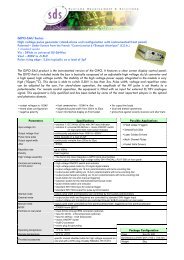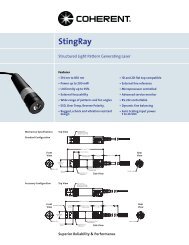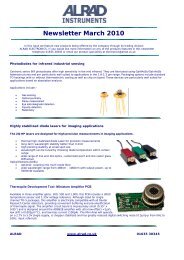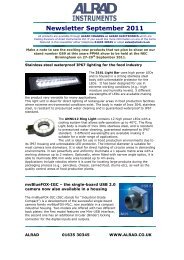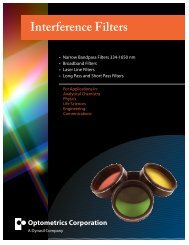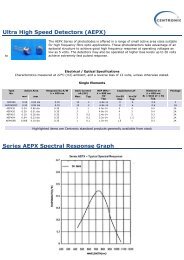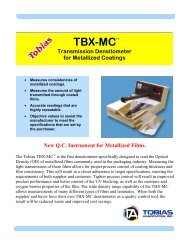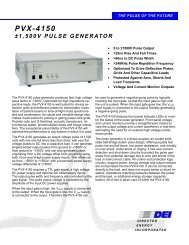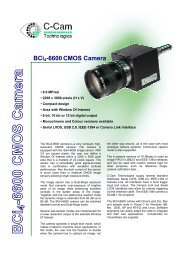PEARSON ELECTRONICS, INC. - Alrad Instruments Ltd.
PEARSON ELECTRONICS, INC. - Alrad Instruments Ltd.
PEARSON ELECTRONICS, INC. - Alrad Instruments Ltd.
You also want an ePaper? Increase the reach of your titles
YUMPU automatically turns print PDFs into web optimized ePapers that Google loves.
Application Notes<br />
For Current Monitors<br />
Manufactured By<br />
<strong>PEARSON</strong> <strong>ELECTRONICS</strong>, <strong>INC</strong>.<br />
History<br />
Pearson Electronics has produced precision<br />
current-monitoring transformers since 1958. The<br />
Pearson design plus careful workmanship and<br />
quality control produce current monitors with<br />
excellent frequency response and amplitude<br />
accuracy. Originally developed for measuring<br />
pulse currents, Pearson Current Monitors are<br />
now also widely used to measure more complicated<br />
transients and periodic signals from a few<br />
hertz to well into the megahertz region.<br />
Operation<br />
To use a Pearson Current Monitor one needs<br />
an oscilloscope and an appropriate length of<br />
coaxial cable, which would usually have a<br />
50 ohm impedance. For RF work an RF voltmeter<br />
may be used. The output receptacle of<br />
the current monitor is connected via the coaxial<br />
cable to the high-impedance oscilloscope or<br />
voltmeter input. The conductor carrying the<br />
current to be measured is passed through the<br />
hole in the current monitor. The voltage waveshape<br />
as displayed on the oscilloscope will then<br />
be a faithful reproduction of the actual current<br />
waveshape within the limitations of rise time and<br />
droop specified for the particular model used.<br />
The voltage amplitude will be related, on a linear<br />
basis, to the current amplitude by the sensitivity<br />
in volts-per-ampere.<br />
Performance Features<br />
The standard accuracy for Pearson Current<br />
Monitors is within +1%, -0% of the nominal<br />
sensitivity. This accuracy applies to the midband<br />
response. Exceptions due to droop and monitor<br />
rise-time (low and high frequency cut-off) are<br />
particular to each model, and are treated<br />
separately in the specification sheet. Rise time is<br />
short, ranging between 2 and 100 nanoseconds<br />
(10-90% levels) in most cases. Droop values<br />
range from 0.1% per microsecond to 0.5% per<br />
millisecond for typical models. A significant<br />
advantage, of course, is the fact that the current<br />
monitor is physically isolated from the circuit<br />
under test.<br />
This feature is invaluable for eliminating ground<br />
currents which usually occur when using current-viewing<br />
resistors. Another advantage is that<br />
low sensitivity can be used without suffering<br />
from the ringing commonly encountered with<br />
viewing resistors.<br />
Typical Applications<br />
Pearson Current Monitors can be used for<br />
measuring and monitoring:<br />
• Current waveshape and amplitude in high and<br />
low voltage circuits, from microamperes to<br />
megamperes.<br />
• Circuits where the use of viewing resistors is<br />
unsuitable because of ground-loop noise,<br />
insertion resistance, or a lack of high voltage<br />
isolation.<br />
• Pulse currents at high voltage, as associated<br />
with microwave or x-ray tube modulators,<br />
particle accelerators and lasers.<br />
• Current transients and harmonics in power<br />
systems.<br />
• Lightning-strike currents.<br />
• Pulsed charged-particle beam current.<br />
• Current in electrolytes and plasmas.<br />
• EMI currents.<br />
• Video and RF currents.<br />
• Currents in spot and induction welders.<br />
• Antenna phasing.<br />
• Flash-tube current.<br />
Calibration<br />
Pearson Current Monitors intended for general<br />
use are adjusted at the factory to yield an initialpulse-amplitude<br />
error within specification (either<br />
±1% or +1, -0% depending on model), when<br />
terminated in a high impedance load such as an<br />
oscilloscope. The equivalent circuit of nearly<br />
every Pearson Current Monitor is that of a<br />
voltage generator in series with 50 ohms.<br />
<strong>Alrad</strong> Electronics, Turnpike Road Ind Estate, Newbury, Berkshire RG14 2NS Tel. 01635 30345• FAX 01635 32630• Web: www.alrad.co.uk
Specifications<br />
A review of certain Pearson Current Monitor<br />
specifications may assist the engineer in choosing<br />
the right model for a particular application.<br />
• Sensitivity The considerations here involve the<br />
peak current to be measured, the oscilloscope<br />
sensitivity, and trade-offs imposed by other<br />
specifications.<br />
For Pulse Applications<br />
The Time Domain Parameters Are:<br />
• Maximum Peak Current This value is based<br />
primarily on the voltage-breakdown rating of the<br />
connector used. For instance, a 500-volt rating<br />
on the connector gives a 5000-ampere peak<br />
current rating for a 0.1 volt-per-ampere current<br />
monitor.<br />
• Droop The value listed is the maximum<br />
amount to be expected at current levels above a<br />
few amperes. At low current levels, low initial<br />
core permeability may cause higher droop<br />
values and a corresponding increase in the lowfrequency<br />
-3 dB point for some models.<br />
• Usable Rise Time If the 10 to 90 percent rise<br />
time is greater than the specified usable rise<br />
time, initial overshoot and ringing will be less<br />
than 10% of the pulse step amplitude.<br />
• I . t Max This parameter is analogous to the<br />
voltage-times-time constant of a pulse transformer.<br />
The product of current times time for a<br />
rectangular pulse must not exceed the value<br />
listed or the core will saturate, causing a distorted<br />
waveform. If two turns are used through<br />
the window to obtain twice as much sensitivity,<br />
the I . t rating necessarily will be halved.<br />
For The Continuous Signal Applications,<br />
The Frequency Domain Parameters Are:<br />
• Maximum RMS Current This value is based<br />
on heating considerations involving the longterm<br />
stability of the internal resistance element<br />
in the current monitor.<br />
• Approximate Low And High Frequency 3 dB<br />
Points Due to the ac nature of transformers, the<br />
flat midband response will roll off at low frequency.<br />
The “corner” or “cut-off” frequency, at<br />
which the response is 3 dB down, is specified.<br />
Internal resonances determine the useful high<br />
frequency cut-off point. Response is within<br />
± 3 dB at the specified high frequency limit.<br />
• I/f Max This parameter is to sine-wave<br />
currents what the I . t product is to rectangularwave<br />
currents. The quotient of peak current<br />
divided by frequency must not exceed the listed<br />
value or the core will saturate. If two turns are<br />
used through the window to obtain twice as<br />
much sensitivity, the I/f rating necessarily will be<br />
halved.<br />
External Termination<br />
When viewing pulse rise times below 100<br />
nanoseconds, RF currents above a few megahertz,<br />
or when using long cables, it is advisable<br />
to terminate the general-use current monitor<br />
output cable at the oscilloscope with 50 ohms to<br />
prevent standing waves or cable fill-time effects.<br />
With this termination the output voltage will be<br />
approximately half the unterminated value,<br />
subject to the accuracy of the termination<br />
resistance, and the attenuation of the cable.<br />
Fast-rising pulses can produce spurious observed<br />
ringing due to high frequency current<br />
flowing on the outside of the cable shield. This<br />
current can be suppressed by increasing the<br />
inductance of the shield run by threading the<br />
cable through one or more magnetic cores.<br />
Good results have been obtained using three<br />
turns through four ferrite cores of about one inch<br />
inside diameter, two inch outside diameter and<br />
1<br />
⁄2 inch thickness.<br />
With termination, models 2877, 4100, 2100,<br />
3100, 150, 410, 411, 110, 110A, and 1010 will<br />
exhibit lower droop and increased I . t product.<br />
Performance Trade-Offs<br />
In general, as sensitivity decreases, peak<br />
current, rms current, and I . t product increase.<br />
In addition, it is difficult to combine low droop<br />
with high sensitivity.<br />
Electrostatic Shielding<br />
All Pearson Current Monitors which have the<br />
3 1 ⁄2 inch or 10 3 ⁄4 inch diameter hole are double<br />
shielded. The outer shield (case) is automatically<br />
grounded when the threaded mounting holes are<br />
used with metal screws through a grounded<br />
bracket. All other standard Pearson Current<br />
Monitors are single shielded. The shield and the<br />
coaxial cable braid are grounded by the mounting<br />
screws in all models except those having a<br />
2-inch diameter hole. These have insulated<br />
mounting brackets and the only grounding is<br />
through the cable braid to the oscilloscope.<br />
Biasing<br />
All Pearson Current Monitors use ferromagnetic<br />
cores which can become saturated by the dc<br />
component (average value) of the current (I dc),<br />
or by the current-time product (I . t) of the pulses.<br />
Since the output of the monitor is sustained by the<br />
changing flux level in the core, magnetic saturation<br />
will degrade performance. As a function of<br />
increasing I dc , the effective permeability of the<br />
core decreases, causing the droop rate and lowfrequency<br />
cut-off point to increase. Also, the<br />
available flux swing is decreased, reducing the<br />
maximum viewable I . t. When viewing a pulse,<br />
the output voltage will drop to zero when the<br />
<strong>Alrad</strong> Electronics, Turnpike Road Ind Estate, Newbury, Berkshire RG14 2NS Tel. 01635 30345• FAX 01635 32630• Web: www.alrad.co.uk
integrated value of current with respect to time<br />
causes the flux level to reach saturation. The<br />
monitor will recover after the applied current<br />
returns to zero and the flux returns to its remanent<br />
value.<br />
Biasing can enable operation with a larger dc<br />
component of current, and/or improve the<br />
maximum viewable current-time product. The<br />
objective of biasing is to reset the flux in the core<br />
to a value near the negative saturation level so<br />
that the maximum flux swing is available.<br />
The I . t value given in the specification sheets is<br />
based on a flux swing from zero to saturation for<br />
all models. However, models indicated in the<br />
specification sheet with ** have high-permeability<br />
core material which has a residual induction of<br />
0.6 to 0.8 of the saturation value. These models<br />
will need bias to obtain more than 0.2 to 0.4 of<br />
the rated I . t. With bias all models can achieve<br />
nearly twice the specified I . t, since the flux can<br />
be reset close to negative saturation.<br />
For pulses with small I . t, the droop rate will<br />
increase as I dc approaches “I dc max ” in the table.<br />
I dc max is the approximate level at which the droop<br />
rate will be doubled. In this situation, bias is<br />
used to cancel I dc and allow normal operation.<br />
I dc max<br />
I bias<br />
Model (A) (A) Ratio<br />
2877 0.17 0.13 50<br />
4100 0.32 0.25 50<br />
2100 0.78 0.59 50<br />
3100 1.9 1.4 50<br />
150 0.78 0.59 99<br />
325 25 142<br />
2878 0.17 0.13 45<br />
410 10 424<br />
411 0.32 0.25 424<br />
110 0.78 0.59 414<br />
110A 0.78 0.59 414<br />
310 25 352<br />
1010 160 120 490<br />
1025 8 361<br />
3025 25 513<br />
2879 0.17 0.13 46<br />
101 0.78 0.59 325<br />
301X 60 312<br />
1080 60 173<br />
1330 60 345<br />
1423 60 80<br />
2093 150 473<br />
Bias current may be applied via an additional<br />
primary wire through the current monitor hole<br />
and should be of the opposite polarity to the<br />
expected signal. The correct value for the bias<br />
current is I dc , plus, for ** models, “I bias ” from the<br />
table. The bias current source must have<br />
enough resistance to avoid the effect of a<br />
shorted turn through the core.<br />
Bias current may also be injected into the secondary<br />
winding via a “T” adapter connected to<br />
the output connector. The load at the instrument<br />
end of the cable should be high enough so that<br />
no significant bias current is diverted from the<br />
monitor. The source resistance of the bias current<br />
source must not load the output of the current<br />
monitor. For models with 50 ohm output resistance,<br />
a bias source resistance of 5000 ohms will<br />
result in a -1% shift in sensitivity. The amount of<br />
current to be applied with this method is that<br />
which was calculated above divided by “Ratio”<br />
from the table.<br />
In a pure ac signal, I dc is zero and the I . t of the<br />
positive and negative parts of the cycle are<br />
equal. The “I/f” value from the specification<br />
sheet gives the maximum amplitude for a sine<br />
wave of frequency f. Biasing cannot improve<br />
performance for ac signals.<br />
Transient Limitation<br />
When monitoring high current transients it is<br />
possible to exceed the internal dissipation limits<br />
of the unit. For unidirectional currents saturation<br />
of the core protects the secondary circuit. The<br />
energy of a bidirectional transient is not limited<br />
in this way. The heat generated by such a<br />
transient current is proportional to the time<br />
integral of the square of the current. For any<br />
given model the limit can be found by multiplying<br />
the peak current rating by the I . t product.<br />
Exceeding this I 2 t value may damage the unit.<br />
For example, the I 2 t limit for the 301X would<br />
be 50 kA times 22 A-sec, or 1.1 x 10 6 A 2 -sec.<br />
If an ac current of 5 kA RMS were applied, the<br />
maximum duration should be 1.1 x 10 6 ⁄(5 x 10 3 ) 2<br />
= 4.4 x 10 -2 sec.<br />
Phase Shift<br />
Within their specified frequency ranges, the<br />
phase shift between the voltage output and<br />
the current being measured by Pearson Current<br />
Monitors is small. For frequencies at least one<br />
decade from the low and high frequency cutoff<br />
points, the phase shift is usually less than<br />
6 degrees, and the amplitude error is less than 1%.<br />
<strong>Alrad</strong> Electronics, Turnpike Road Ind Estate, Newbury, Berkshire RG14 2NS Tel. 01635 30345• FAX 01635 32630• Web: www.alrad.co.uk
High-Voltage Consideration<br />
Pearson Current Monitors intended for highvoltage<br />
use have large hole diameters and<br />
radiused edges to keep voltage gradients low.<br />
The two standard case sizes are those with<br />
3 1 ⁄2 inch and 10 3 ⁄4 inch inside diameters. These<br />
sizes are double shielded, as mentioned previously.<br />
The extra shield affords excellent protection<br />
from electric field penetration. Since the<br />
mounting screws ground the outer shield, a<br />
direct path to ground is provided for possible<br />
arcs from the high-voltage conductor to the<br />
case. This direct path to ground minimizes the<br />
danger of high voltage entering the instrumentation<br />
circuit. The inner shield and coaxial connector<br />
are “floating” and hence can be grounded at<br />
the oscilloscope, at the oil tank bulkhead, or<br />
wherever convenient to minimize ground loops<br />
and promote safety.<br />
A round conductor at high potential centered in<br />
the hole of a Pearson Current Monitor results in<br />
coaxial geometry. For this arrangement, the<br />
minimum voltage gradient at the surface of the<br />
conductor occurs when the ratio of conductor<br />
radius to hole radius is 1/e. Departure in either<br />
direction from the optimum conductor radius will<br />
increase the gradient and lower the permissible<br />
operating voltage. Voltages and recommended<br />
conductor sizes are tabulated for three Pearson<br />
case sizes. Cleanliness of the local environment<br />
is necessary to achieve reliable high-voltage<br />
operation.<br />
Typical Pulse Flashover<br />
Hole Conductor Voltage Voltage<br />
Diameter Diameter *in Oil in Air<br />
2” 3<br />
⁄4” 150kV 30kV<br />
3 1 ⁄2” 1 1 ⁄4” 300kV 50kV<br />
10 3 ⁄4” 4” 900kV 150kV<br />
*Note: For pulses of under five microseconds duration.<br />
All Pearson Current Monitors are constructed of<br />
materials compatible with transformer oil. For<br />
detailed information regarding the care and<br />
handling of transformer oil, use of pulse transformers<br />
in transformer oil, etc., refer to Pearson<br />
“Notes on High-Voltage Pulse-Transformer<br />
Insulating Oil Care and Accidental Transformer<br />
Overvoltages” (available on request from the<br />
Pearson factory).<br />
When the conductor in the hole of a Pearson<br />
Current Monitor operates at a high direct-current<br />
potential in transformer oil, it is recommended<br />
that a barrier composed of solid insulating<br />
material be placed between the conductor and<br />
the current monitors to prevent arcs due to<br />
foreign particles “lining up” in the dc field.<br />
Typical barrier materials include teflon tubing,<br />
laminated paper-phenolic tubing and oil-impregnated<br />
(by vacuum) Kraft paper. If the barrier<br />
material is used as a centering device, touching<br />
both conductor and current monitor, adequate<br />
creep distance should be allowed over the<br />
shortest surface path to prevent breakdown.<br />
At voltage levels of a few kilovolts in air, ordinary<br />
high-voltage insulated wire will suffice for the<br />
center conductor. At levels above 10 kilovolts in<br />
air, it is advisable to use a centered conductor of<br />
large diameter. As the voltage level approaches<br />
the rated voltage for the hole size, it becomes<br />
more necessary to use the optimum conductor<br />
size.<br />
Insertion Resistance<br />
A typical Pearson Current Monitor contains a<br />
distributed load resistance. When using such a<br />
current transformer this resistance appears as a<br />
very small equivalent series resistance in the<br />
circuit being measured. This resistance is<br />
usually so small it can be neglected. For those<br />
cases when it needs to be considered,<br />
the values are tabulated here.<br />
Model Nos. Insertion Resistance (Ohms)<br />
2877, 4100, 2100, 3100 0.02<br />
150 0.005<br />
325



